UC Berkeley launches landmark $6 billion fundraising campaign
More than $3 billion, including two major gifts to fund a data science building and rename the College of Natural Resources, already have been raised in the campaign's quiet phase

February 29, 2020
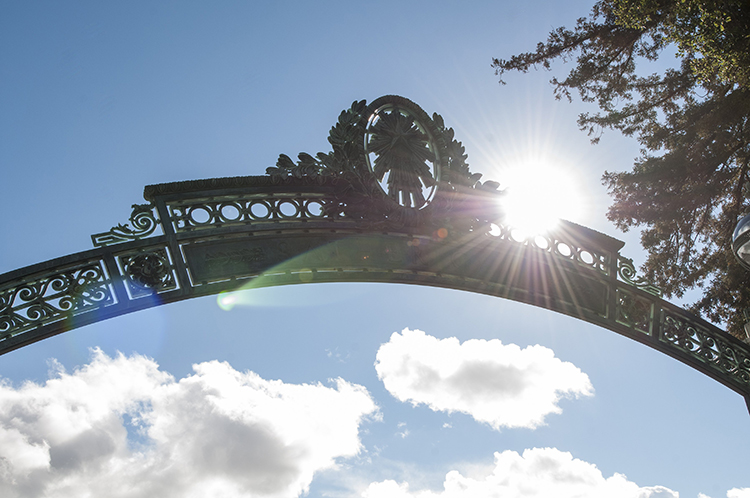
Berkeley’s fourth comprehensive capital campaign, Light the Way: The Campaign for Berkeley, is one of the largest launched by any U.S. university, public or private. (UC Berkeley photo by Keegan Houser)
The University of California, Berkeley, today (Saturday, Feb. 29) publicly launched the largest fundraising campaign in its history, to raise $6 billion by the end of 2023. The ambitious goal — the highest set by any U.S. public university without a medical school — aims to secure UC Berkeley’s status as the world’s top public research and teaching university at a time when the state funds about 14% of its budget.
The campaign is one of the largest taken up by any university, public or private, in the nation.
Tops on UC Berkeley’s list of must-haves — to continue its comprehensive academic excellence, public mission and reputation as a powerful agent of upward mobility for low-income students — are 100 new tenure-track faculty positions; 300 new graduate student fellowships; a dramatic increase in the number of undergraduate scholarships; campus housing for all freshmen, sophomores and first-year transfer students; and support for research to transform health, the environment and society.
Making sure UC Berkeley’s students and faculty are equipped to make that impact is at the heart of Light the Way: The Campaign for Berkeley, which, since its quiet phase began Jan. 1, 2014, already has raised $3.4 billion. The funding quest — for basics like financial aid, faculty positions, lab equipment and beds — is a sharp departure from the mission of previous comprehensive fundraising campaigns at Berkeley; the first, Keeping the Promise, ran from 1985 to 1990 and raised $466.6 million.
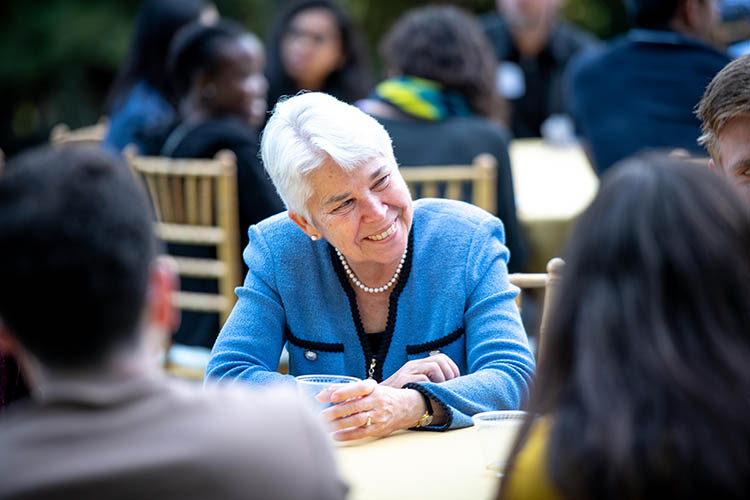
Chancellor Carol Christ says the massive campaign is “for our core needs and activities …. for the heart and soul of the university and all that sets Berkeley apart from the crowd.” (UC Berkeley photo by Keegan Houser)
In the era of that first campaign, about 50% of UC Berkeley’s budget was paid by the state — an even higher amount, nearly 70%, was received by the University of California system from the state in the early 1950s, when the UC had only a few general campuses — and philanthropy typically was sought for “nice-to-haves, the extra embellishments not necessarily provided by state funding,” said Chancellor Carol Christ.
“Now, however, we are raising funds for our core needs and activities … for the heart and soul of the university and all that sets Berkeley apart from the crowd,” she said. “It may seem ironic, but it is the support from private sources that helps us to secure and sustain our public character, which is stronger than ever.”
Berkeley’s new fundraising strategy follows that of its private college and university peers, which can build their security only through gifts and have become adept over decades at running massive campaigns to fund the full gamut of their academic institutions’ needs.

A data hub, to house Berkeley’s new Division of Computing, Data Science, and Society, will emerge from this open space at the intersection of Hearst Avenue, Arch Street and MacFarlane Lane. (UC Berkeley photo by Keegan Houser)
Among the major gifts already brought in during Light the Way’s quiet phase is an anonymous $252 million, the largest single gift Berkeley has ever received, to seed construction for a home for Berkeley’s new Division of Computing, Data Science, and Society. In that teaching and learning data hub, students and faculty from a variety of disciplines will tackle challenges — including how to protect individuals’ privacy, advance human well-being and make data-informed public policy — using machine learning, artificial intelligence, advanced statistics and other new technologies. Data science is the fastest growing major on campus.
Another gift, $50 million from Gordon Rausser, former dean of the College of Natural Resources, will boost Berkeley’s leadership in addressing environmental and health challenges. The college’s largest donation to date will further initiatives there such as mitigating and adapting to climate change, accelerating the clean energy transition and improving food security and nutrition for all. To honor the donor’s gift, the college has been renamed the Rausser College of Natural Resources.

In Doe Library, popular and prize-winning astronomy professor Alex Filippenko, who was on both teams that revealed the accelerating expansion of the universe, shares insights with students. The capital campaign seeks 100 more tenure-track professors to begin to match the dramatic growth of the student body. (UC Berkeley photo by Keegan Houser)
More faculty, more for faculty
In the past five years, the number of Berkeley undergraduates has increased 14%, to 29,010, according to spring campus census data. Meanwhile, financial constraints have kept Berkeley from increasing its ladder-rank faculty, from assistant professors to associate professors to professors. Their numbers instead have dropped to 1,466, by 2%, or 32 people.
The campaign seeks to add 100 new tenure-track faculty members and the resources they need to conduct critical research alongside students. Berkeley competes worldwide with its peers to add top scholars to its ranks, but to succeed, it must keep pace with the support other schools can offer for faculty recruitment, retention and research.
“The faculty is the definitive factor at Berkeley in enabling our students to become leaders in an astonishingly broad array of fields,” said Paul Alivisatos, executive vice chancellor and provost. “Philanthropy will allow us not only to hire more professors, but to provide them with the resources they need to make path-breaking discoveries.”
“Part of Berkeley’s mission,” added Vice Provost for the Faculty Ben Hermalin, “is to provide students with access to the leading minds in their fields, who will ensure they can enter the workforce or go to top graduate schools informed by the latest information. Growing the faculty is a way to fulfill our mission to advance knowledge and, so, to serve as an engine of economic prosperity and human betterment.”
And without enough professors, “either class sizes get enormous, or we ration the number of students who take courses or even major in certain fields,” he said. “Because more students mean more advising and more office hours, the faculty workload becomes greater, reducing the time for research and other activities.”
To compensate for the growth in undergraduate enrollment relative to faculty recruitment, campus leaders have said that many new hires are needed, but that bringing in 100 ladder-rank faculty over the next five years is an important first step.
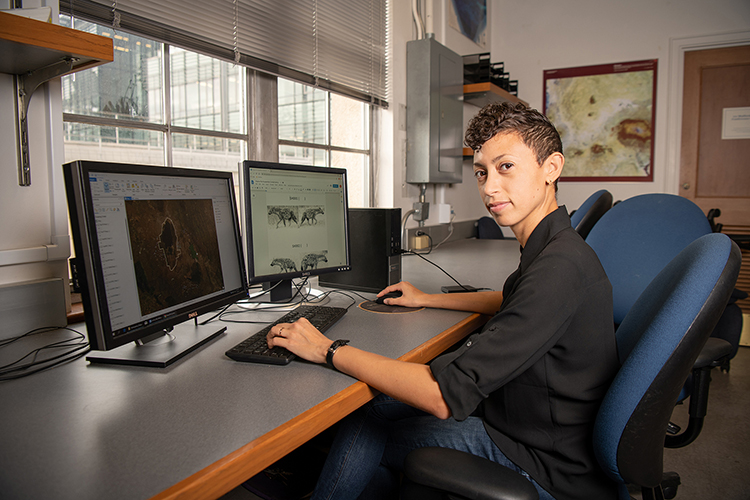
Ph.D. student Christine Wilkinson says more endowed graduate student fellowships from the campus, like the one she had her first two years at UC Berkeley, are needed to help students focus on their work, not on their basic needs. (UC Berkeley photo by Keegan Houser)
Help for undergrads, grad students to excel
Berkeley also competes fiercely for the world’s most promising graduate students. Another campaign priority is to raise funds for 300 new graduate student fellowships. With some 12,000 graduate students, Berkeley is one of the top five U.S. universities for granting doctoral degrees and has more than 110 advanced degree programs ranked in the top 10.
Ph.D. student Christine Wilkinson, from Queens, New York, says a graduate student fellowship — in her case, a campus Chancellor’s Fellowship — allowed her to “find a place to live and fulfill my basic living needs for my first two years at Berkeley. Without it, it would be very difficult to live in the Bay Area.”
Wilkinson, in the Department of Environmental Science, Policy and Management, studies human-wildlife conflict and carnivore movement ecology. She chose Berkeley specifically to work in the Brashares Group with Justin Brashares, professor of wildlife ecology and conservation, and in the Kellylab with environmental science, policy and management professor and cooperative extension specialist Maggi Kelly. Wilkinson is an advocate of using applied participatory research and empowering community-created solutions to conservation challenges.
Acquiring additional fellowships for graduate students, she said, “would help them survive, be able to eat, have a place to live, and thus be more likely to graduate in normative time.”
Equipping undergraduates to excel — with affordable, convenient campus housing, scholarships and research opportunities — is another major focus of the campaign. Currently, the campus is able to provide just 27% of its students with a spot in its residence halls, and there aren’t enough highly successful undergraduate mentorship and intellectual discovery opportunities to go around.
Many Berkeley students find that living costs in the Bay Area are the most expensive part of college. The chancellor has vowed to double the number of campus beds for undergraduates in the next 10 years and to develop campus housing on all available sites. She also aims to triple the number of graduate students that Berkeley can house.
Currently, with 9,621 beds, the campus houses more than 6,500 first-year undergraduates; the remaining beds are for other undergraduates, graduate students and student families.
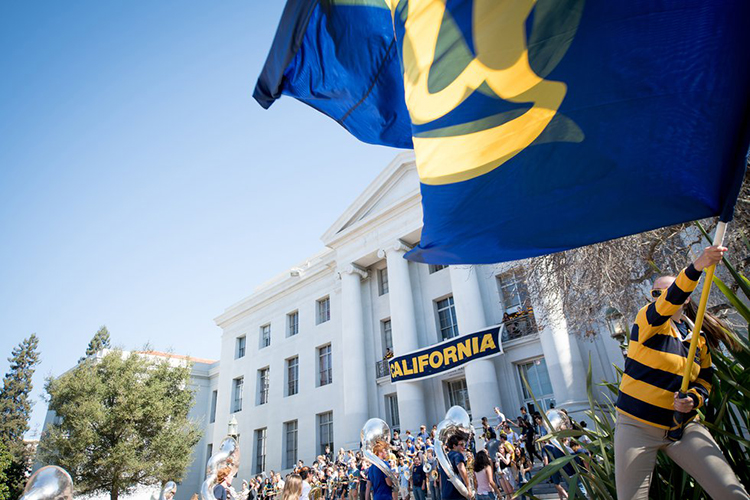
The mission of Light the Way is sharply different from past comprehensive capital campaigns. It seeks funds for core needs and activities, not “nice-to-haves,” said Chancellor Carol Christ. (UC Berkeley photo by Keegan Houser)
In addition to the stress of high rent, financial worries can distract students from their studies, research projects and internships and lead to basic needs insecurity. While two-thirds of Berkeley students receive financial aid, Berkeley provides less than 20% of its students with scholarships. Thirty percent of freshmen and 55% of transfer students qualify as low-income, and thanks to grants and scholarships, 38% pay nothing out of pocket, and almost half their total cost of attendance is covered.
For the campus to continue as “a beacon of hope and opportunity” for low-income students, said Cruz Grimaldo, assistant vice chancellor and director in the Financial Aid and Scholarships Office, “undergraduate scholarships must keep pace with increased costs and are the only component of our financial aid program that the campus community can directly impact. Scholarships make a world-class education a reality for thousands of Berkeley students each year.”
Students who receive such support thrive not only at Berkeley, but make huge gains in their lives after graduation.
In an Equality of Opportunity Project report card published by economists in 2017, UC Berkeley was the top-ranked California school in the nation — from community colleges to four-year colleges and universities — for “upper-tail upward mobility.” Among colleges in the study with at least 500 students per cohort, UC Berkeley had the largest fraction of students from families in the bottom fifth of income distribution who ended up in their early 30s with earnings in the top 1%.
New research frontiers, experiential learning
For Vice Chancellor for Undergraduate Education Cathy Koshland, “equitable access to discovery experiences, such as research and engaged scholarship, Berkeley Study Abroad and internships should be the heart of the undergraduate experience for each of our students.”
An increasingly popular program like Berkeley Connect, which pairs undergrads with a graduate student mentor and connects them to students and professors who share their academic interests, “creates a community and a sense of belonging” on a large campus, she said.
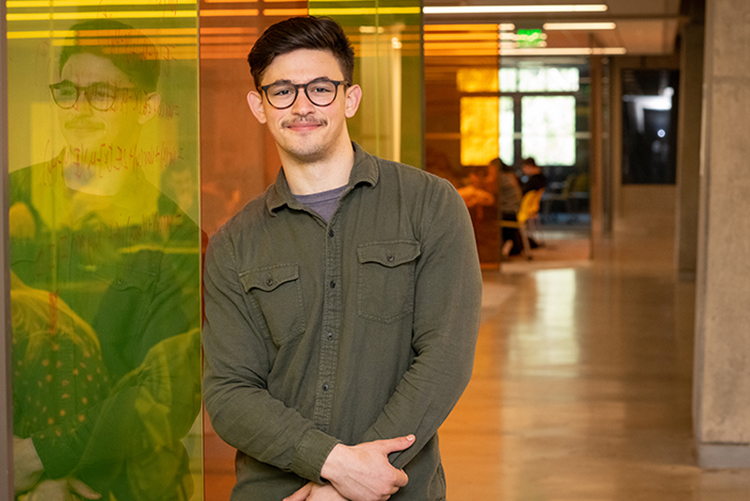
Undergraduate Alexander Ladd says the research opportunities he’s had with professors have helped him grow personally and academically. (UC Berkeley photo by Keegan Houser)
Undergraduate Alexander Ladd, a data science and cognitive science double major from Los Angeles, agrees. Without the opportunities he’s had to do research with professors through Berkeley’s Undergraduate Research Apprentice Program (URAP), which pairs faculty with students who want to engage in advanced research, “I would definitely have lower aspirations and believe in myself less.”
He said the chance to do neuroscience research at Lawrence Berkeley National Laboratory and to design, as part of a student team, a data-enabled dashboard to help campus advisers and students track capacity in data science courses also sharpened the communication and time management skills he’ll need throughout his career.
With campaign dollars, the campus hopes to expand URAP, provide any undergraduate with financial need a summer experience in research, community engagement, creative arts or entrepreneurialism through Berkeley Discovery, and increase Berkeley Connect’s reach from 1,500 students to all freshmen and transfer students.
Berkeley’s fundamental research, often the result of interdisciplinary teamwork, has led to countless critical discoveries. One example is the CRISPR-Cas9 gene-editing technology, hailed as the scientific breakthrough of the century for its ability to modify and repair the human genome. Another is a novel hypothesis about the onset of Alzheimer’s and related brain diseases.
Areas of research for the public good that Berkeley is best suited to tackle in this decade, and that are a capital campaign focus, include the environment, data science and artificial intelligence, democracy and equality, health, and innovation and entrepreneurship.
“What motivates our faculty is their focus on the really big questions, like the origins of the universe and the development of life, and the creation of new technologies, like genome engineering, AI and data science,” said Vice Chancellor for Research Randy Katz. “Hiring faculty and providing graduate fellowships in these interdisciplinary areas, as well as obtaining program support to seed activities and interactions, will lead to new tools and possible solutions to the really big problems facing 21st century society.”
Christ said that proceeds from this ambitious campaign will do much more than “simply sustain the status quo.”
“I am thrilled that we are now on the way to providing students with more housing, scholarships and modern academic facilities, even as we expand the ranks of faculty and develop new learning and experiential opportunities,” she said. “As our students benefit, so does the public we serve at a time when Berkeley’s societal and academic role has never been more important.”